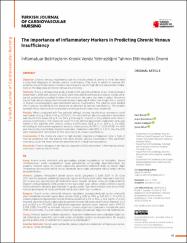| dc.contributor.author | Demırkıran, Aykut | |
| dc.contributor.author | Çalışkan, Serhat | |
| dc.contributor.author | Böyük, Ferit | |
| dc.contributor.author | Altun, Şenel | |
| dc.date.accessioned | 2023-05-06T17:23:34Z | |
| dc.date.available | 2023-05-06T17:23:34Z | |
| dc.date.issued | 2022 | |
| dc.identifier.issn | 2149-4975 | |
| dc.identifier.uri | https://doi.org/10.5543/khd.2022.211825 | |
| dc.identifier.uri | https://search.trdizin.gov.tr/yayin/detay/1123910 | |
| dc.identifier.uri | https://hdl.handle.net/20.500.11776/12154 | |
| dc.description.abstract | Objective: Chronic venous insufficiency can be missed unless it comes to mind. We need a simplified diagnosis of chronic venous insufficiency. This study is aimed to analyze the potential role of inflammatory markers like monocyte count/high-density lipoprotein cholesterol on the diagnosis of chronic venous insufficiency. Methods: This is a retrospective study. A total of 419 patients admitted to our clinics between September 1, 2019, and January 20, 2021, were included. Blood tests and venous Duplex ultrasound examinations applied to lower limb veins on the same day were studied. Monocyte count/high-density lipoprotein cholesterol was measured. A reflux time longer than 1 second in Duplex ultrasonography was considered venous insufficiency. The patients were divided into 2 groups according to the presence or absence of venous insufficiency. The relation between these results and the presence of venous insufficiency was examined. Results: When compared with the patients without venous insufficiency, monocyte count was higher (0.61 ± 0.18 vs. 0.55 ± 0.15 109 /L; P = .00) and high-density lipoprotein cholesterol was found to be lower (49 ± 9.1 vs. 53.4 ± 13.6 mg/dL; P = .02) in the patients with chronic venous insufficiency. The monocyte count to high-density lipoprotein cholesterol ratio was higher in the patients with chronic venous insufficiency (12.5 ± 5 vs. 10.9 ± 4; P = .005). According to multivariate regression analysis, monocyte count (95% CI: 1.003-1.035; P = .020) and monocyte count to high-density lipoprotein cholesterol ratio (95% CI: 1.017-1.154; P = .013) were independent risk factors for the occurrence of venous insufficiency. Conclusions: If the monocyte count to high-density lipoprotein cholesterol ratio is high, it may be predicted that this patient may have chronic venous insufficiency. This prediction may focus us on the lower extremity examination in clinical routine practice. | en_US |
| dc.language.iso | eng | en_US |
| dc.identifier.doi | 10.5543/khd.2022.211825 | |
| dc.rights | info:eu-repo/semantics/openAccess | en_US |
| dc.title | The Importance of Inflammatory Markers in Predicting Chronic Venous Insufficiency | en_US |
| dc.type | article | en_US |
| dc.relation.ispartof | Kardiyovasküler Hemşirelik Dergisi | en_US |
| dc.department | Fakülteler, Tıp Fakültesi, Dahili Tıp Bilimleri Bölümü, Kardiyoloji Ana Bilim Dalı | en_US |
| dc.identifier.volume | 13 | en_US |
| dc.identifier.issue | 31 | en_US |
| dc.identifier.startpage | 61 | en_US |
| dc.identifier.endpage | 64 | en_US |
| dc.institutionauthor | Demırkıran, Aykut | |
| dc.relation.publicationcategory | Makale - Ulusal Hakemli Dergi - Kurum Öğretim Elemanı | en_US |
| dc.identifier.trdizinid | 1123910 | en_US |



















